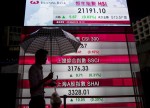
- All Instrument Types
- Indices
- Equities
- ETFs
- Funds
- Commodities
- Currencies
- Crypto
- Bonds
- Certificates
Please try another search

Should You Play These ETF Strategies As Fed Meets?

In the Fed meeting that is about to start, asset rollback is the bank’s top priority. It is also investors’ top concern. So far, weaker inflation has kept the Fed from being too aggressive on the rate hike issue, but inflation has picked up lately (read: ETFs to Benefit from Rising Inflation).
This gives the Fed a leeway to act freely in the days to come. In any case, the Fed indicated in its July meeting that it plans to start normalization of its $4.5-trillion balance sheet "relatively soon." The Fed had pursued three rounds of "quantitative easing" or QE since the 2008 recession. As a result, the balance sheet ballooned over the years thanks to buying of Treasuries and mortgage-related debt.
The move was aimed at goading economic activity. Now, the Fed is planning to end reinvestment of the proceeds from these bonds. Market watchers now expect the asset rollback policy to be announced in September.
“The plan is for the Fed to allow $10 billion of the monthly proceeds it gets from the portfolio to run off at first, increasing in $10 billion quarterly increments until the total reaches $50 billion,” as per CNBC.
Impact of Reverse QE
Whatever the case, bond yields are likely to increase from such moves. Though yield on the 10-year U.S. Treasury note is hovering around 2.23% (as of Sep 18, 2017), after the announcement of the reverse QE, bond yields should jump. Plus, hopes of tax cuts should give another round of upward pressure to the bond yields. David Kostin, Goldman's chief equity strategist, also sees a likely rise in rates.
Is Steepening of the Yield Curve Likely?
If everything remains sturdy on the global economic front and no geopolitical crisis flares up causing a safe-haven rally, long-term interest rates should go up from a reverse QE. In fact, mortgage and other rates are expected to go up faster than investors’ expectations.
On the other hand, the Fed may stay away from a steeper short-term rate hike trajectory if it starts unwinding bond holdings alongside. This scenario would result in the steepening of the yield curve.
Given this, investors must be interested in finding out all possible strategies to weather a sudden jump in interest rates. For them, below we highlighted a few investing tricks that could gift investors with gains in a rising rate environment.
ETF Strategies
Bet on Banks
Along with Goldman, we also believe that bank stocks are good bets now in a rising rate environment. SPDR S&P Bank (MX:KBE) ETFKBE and PowerShares KBW Regional Banking ETF KBWR gained about 1.2% and 1.3% on Sep 18, 2017.
Go Short with Rate-Sensitive Sectors
Needless to say, sectors that perform well in a low-interest-rate environment and offer higher yield, may falter when rates rise. Since real estate and utilities are such sectors, it is better to go for inverse REIT or utility ETFs. ProShares Short Real Estate REK and ProShares UltraShort Utilities (LON:SDP) are such inverse ETFs that could be winners in a rising-rate environment (read: Rate Hike Bet Put These Inverse Sector ETFs in Focus).
Ex-Rate Sensitive ETFs Deserves a Look
Since fears of a bubble in the market and the likely steepening of the yield curve may cause considerable volatility, a low volatile and an ex-rate sensitive pick like &P 500 ex-Rate Sensitive Low Volatility Portfolio XRLV should be an intriguing choice.
High Dividend ETFs to Rescue
Investors can seek refuge in even higher-yield securities. So, PowerShares S&P 500 High Dividend Portfolio SPHD yielding about 3.59% annually can be a nice bet in a rising-rate environment. Fidelity Dividend ETF for Rising Rates FDRR can also be a good pick right now (read: 5 Hot Global Dividend ETFs).
Inverse Bond ETFs
Last but not the least, who can forget inverse bond ETFs in such a scenario? The product Barclays (LON:BARC) Inverse US Treasury Aggregate ETN (CM:TAPR) looks to track the sum of returns of periodically rebalanced short positions in equal face values of each of the Treasury Futures’ contracts (see all Inverse Bond ETFs here).
Want key ETF info delivered straight to your inbox?
Zacks’ free Fund Newsletter will brief you on top news and analysis, as well as top-performing ETFs, each week. Get it free >>
SPDR-KBW BANK (KBE): ETF Research Reports
PWRSH-KBW RBP (KBWR): ETF Research Reports
PRO-ULS UTIL (SDP): ETF Research Reports
FID-DIV RR (FDRR): ETF Research Reports
PWRSH-SP5 XRATE (XRLV): ETF Research Reports
PRO-SH REAL EST (REK): ETF Research Reports
BARCLY-INV USTC (TAPR): ETF Research Reports
PWRSH-SP5 HI DV (SPHD): ETF Research Reports
Original post
Related Articles

The markets have been sluggish this week as investors hope for a jolt later in the week when AI juggernaut NVIDIA Corporation (NASDAQ:NVDA) reports fourth quarter and year-end...

On Friday, a wave of selling pressure swept across the US equity markets, leaving a trail of losses. The S&P 500 closed down 1.7%, the DOW slid 1.69%, and the NASDAQ tumbled a...

Palantir remains highly valued with a 460x P/E ratio and a 42.5x P/B ratio, far above its peers. The stock's beta of 2.81 signals high volatility, meaning sharp moves in both...
Are you sure you want to block %USER_NAME%?
By doing so, you and %USER_NAME% will not be able to see any of each other's Investing.com's posts.
%USER_NAME% was successfully added to your Block List
Since you’ve just unblocked this person, you must wait 48 hours before renewing the block.
I feel that this comment is:
Thank You!
Your report has been sent to our moderators for review




Add a Comment
We encourage you to use comments to engage with other users, share your perspective and ask questions of authors and each other. However, in order to maintain the high level of discourse we’ve all come to value and expect, please keep the following criteria in mind:
Enrich the conversation, don’t trash it.
Stay focused and on track. Only post material that’s relevant to the topic being discussed.
Be respectful. Even negative opinions can be framed positively and diplomatically. Avoid profanity, slander or personal attacks directed at an author or another user. Racism, sexism and other forms of discrimination will not be tolerated.
Perpetrators of spam or abuse will be deleted from the site and prohibited from future registration at Investing.com’s discretion.